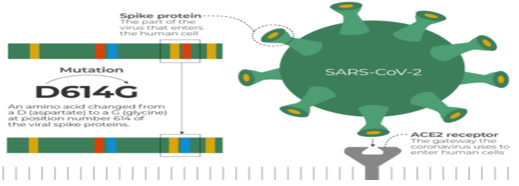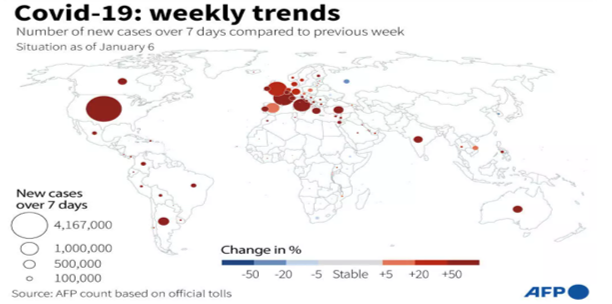- Visibility 10 Views
- Downloads 5 Downloads
- DOI 10.18231/j.ijfcm.2022.010
-
CrossMark
- Citation
A new variant of COVID-19: But is it less deadly?
- Author Details:
-
Samar Hossain
-
Aanchal Anand *
-
Akashdeep Sharma
-
Ukshan Shah
Introduction
As soon as the International flights were about to be resumed and the nationwide cases had reduced to an all-time low for the first time since March 2020, i.e. 6,990 new cases; a new variant emerged, which goes by the name of “OMICRON” — A lot is yet to be discovered about this newly emerged variant, and while scientists are assessing its infectivity, another part of the World is trying to figure out why the World Health Organization have named it skipping two alphabets in the Greek alphabet. This is also a cause of concern for many. Omicron, the name of the new variant, is the 15th letter in the Greek alphabet. The first 12 letters have been used to name the previous strains of the virus. The WHO skipped 13th and 14th letters — Nu and Xi — when choosing a new name for the recently discovered variant. [1]
The omicron variant of Covid-19, first identified in South Africa, has been detected in locations across the globe in countries from U.K. to Spain and Canada, showing the difficulties of curtailing new strains. At the time of penning this article, the new variant has emerged in 17 countries. South Africa has been the first Country to have discovered the variant but that does not necessarily mean that the Country of Origin is South Africa, it could have originated somewhere else but ended up getting discovered in South Africa.[2]
The new Covid-19 variant B.1.1.529 has been named ‘Omicron’ by World Health Organization on 26 November. As of now the new coronavirus variant has reported cases from seventeen countries globally including Australia, Austria, Belgium, Botswana, Canada, Czech Republic, Denmark, Germany, Hong Kong, Israel, Italy, Netherlands, Portugal, South Africa, Spain, Sweden and the United Kingdom. There are probable but yet to be confirmed cases from France, Finland, Japan and Switzerland. The top 5 countries that make majority of the “new variant case load”; they are South Africa- 114 cases, Botswana- 19 cases, Netherlands- 14 cases, Portugal-13 cases and the United Kingdom- 11 cases respectively.[3]
Experts believe there are at least 50 mutations on the new variant, with 32 mutations on the spike protein, the part of the virus that enters human cells. Scientists have said that similar mutations seen in other variants have been associated with higher transmission and a higher chance of escaping the body’s immune defenses, compared with the original strain of the virus. Mutations are identified by letters and numbers such as D614G — which means an amino acid changed from a D (aspartate) to a G (glycine) at position number 614 of the viral spike proteins. Having many mutations does not mean that the virus will be deadlier or more dangerous. Nevertheless, every variant would have the potential to impact the pandemic.[4] However, the data here is very limited at this moment the potential impact and real-world effects as a result of this cannot be commented on at the moment.

On Sunday i.e. 28th November 2021, the WHO said it is not yet clear whether Omicron is more transmissible or causes more severe disease compared with other variants. Preliminary evidence suggests there may be an “increased risk of reinfection with Omicron as compared with other variants of concern, but information is limited”, it said.
According to studies, the “new” variant has been found to pose a very HIGH Global risk. Since this is a newly discovered variant and many more facts are yet to be revealed about this variant then how can is it capable of posing a High Global risk. However, from the information gathered over the past few days since its emergence this variant has been found to cause very mild symptoms. Dr. Angelique Coetzee, chair of the South African Medical Association, who first flagged the new variant, has said that symptoms of the variant are ‘extremely mild’. The symptoms include extreme tiredness which is not limited to any particular age group and scratchy throat. However, no loss of smell or taste was found so far in any of the patients affected by the “new variant”. So far, most of the patients have recovered without any major complications and hospitalization.[5]
Regarding the preventive measures, the variant might be new but the preventive measures are the same. Tried-and-true infection control advice holds as advised by the Experts. How the omicron variant affects the available vaccines remains unclear. But experts say that even if the variant lessens the shots’ effectiveness, it is highly unlikely that it would render them useless.
Conclusion
The US Centers for Disease Control and Prevention (CDC) is working to revise testing requirements for inbound international travelers because of the new Omicron coronavirus variant. The CDC currently requires fully vaccinated travelers to be tested three days before their flight's departure from a foreign country. The CDC continues to recommend, but not require, that travelers get tested three to five days upon return and those who are unvaccinated should quarantine. The CDC did not offer a timeline for when any updated protocols could go into place.
There is a lot more facts and information that is still pending and will be uncovered gradually over time. As of now, all we can do is keep following the COVID protocols, adhere to all the safety measures and be vigilant of any new symptom and any known cluster in a community.
The total number of Covid-19 cases registered worldwide passed 300 million on Friday, with the Omicron variant's rapid spread setting new infection records in dozens of countries over the last week. In the past seven days, 34 countries have recorded their highest number of weekly cases since the start of the pandemic, including 18 nations in Europe and seven in Africa, according to an AFP count based on official figures. Omicron's dizzying spread since being detected six weeks ago has prompted many nations to push harder for more vaccinations and some to clamp down with restrictions.

Different states are in different stages of the pandemic and the ICMR has also changed its testing strategy because of the epidemiological variations in the virus and the pandemic changing its course.
Source of Funding
None.
Conflict of Interest
None.
References
- WHO. Why Omicron? WHO skips two Greek letters in naming new Covid variant. 2021. [Google Scholar]
- . What do we know about the new variant discovered in South Africa? - Archyde [Internet]. Archyde. 2021. 2021. [Google Scholar]
- . The New COVID-19 Variant - Cloud Information and Distribution. 2021. [Google Scholar]
- M Haddad. . Infographic: How Omicron compares with other COVID variants 2021. [Google Scholar]
- . A South African doctor talks about her experience with the symptoms and patients of the mutant "Omicron" | tellerreport. 2021. [Google Scholar]
